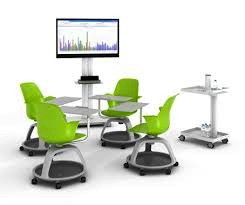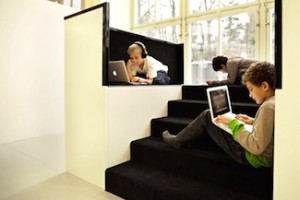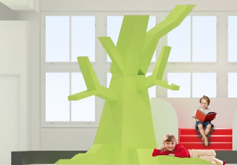Are You Hacking Your School’s Learning Spaces?
 by Emily Vickery
by Emily Vickery
Are there better ways for today’s schools to approach the use of space – ways that promote contemporary student learning at higher levels of engagement and success?
I’ve been mulling over what happens when schools rethink the use of space – shifting from traditional approaches (super-sized cubicles filled with desks) to an emphasis on participatory spaces that take advantage of the research on learning design and the potential of digital technologies to increase the mobility of learning. Isn’t it time we hacked our school learning environments?
Can you really have a 1:1 implementation without asking questions of what learning spaces should now become? – David Jakes
In several posts at my personal blog – here and here – I’ve written about schools (and librarians) that are rethinking the use of space. I find the arguments of Digital Strategist and Designer David Jakes compelling. In his recent post Towards a Consideration of Space, he writes:

New designs for a new generation
Jakes’ observation is supported by UNC Charlotte’s Center for Teaching and Learning in Collaborative Learning Spaces, a report that ties school design thinking to the learning characteristics of New Millennials:
Research shows that student learning styles have changed, therefore we need learning spaces to accommodate a new generation who:
• 
• Are visually‐oriented,
• Are highly networked, interactive and social,
• Are increasingly mobile,
• Have a low tolerance for lecture style teaching,
• Prefer active learning rather than passive learning, and
• Rely heavily on communications technologies to access information and to carry out social and professional interactions.
To meet the principles of contemporary learning, new and refurbished spaces need to be:
• Flexible,
• Connected,
• Collaborative,
• Multisensory, and
• Graphic.
• The new spaces need to be a blend of physical and virtual environments.
As David Jakes suggests, schools are missing out on a huge opportunity to rethink learning spaces when they insert 1:1 computing into the old paradigm of school design. How often have we seen educators layer technology on top of traditional pedagogy, curriculum, assessment, and use of time – choosing to take a tiny step forward instead of a giant leap?
Ideas for reshaping learning spaces
Redesigned spaces can quickly be rearranged to suit various collaborative and instructional scenarios that meet contemporary student learning styles.
Shekou International School did just that. Watch this brief video account of their journey toward creating participatory learning spaces. (You can follow their progress at hashtag #SISrocks.)
Resources to assist K12 educators in “rethinking” space for relevant learning are growing – including ideas about how to undertake your redesign on a shoestring budget.
Here are a few to get you started:

▶ David Jakes – Classroom Redesign: Strategies for Rethinking Learning Spaces

▶ The Third Teacher Presentation – Hack Class: Shape Your Ecology, Empower Learning (8 Tips & Tricks and other handouts available)
▶ Make Space: How to Set the Stage for Creative Collaboration
▶ Teaching the Digital Generation: No More Cookie Cutter High Schools – “The authors show how traditional industrial-type high schools have failed to meet students’ learning needs and explore ten alternative high school models that address 21st-century skills.”

How is your learning organization redesigning space for today’s learners? Are you “hacking” your space to empower learning? Please share your stories!
Emily Vickery is a learning architect, speaker, consultant, and English teacher based in Pensacola, Florida. She has taught technology and ELA courses in public and independent middle and high schools. A former research fellow at Teaching Tolerance (Southern Poverty Law Center), she is a frequent presenter on digital learning topics and a co-author of Teaching 2030: What We Must Do for Our Students & Our Public Schools, Now and in the Future. Learn more about Emily’s work at her Digital CV page.



































